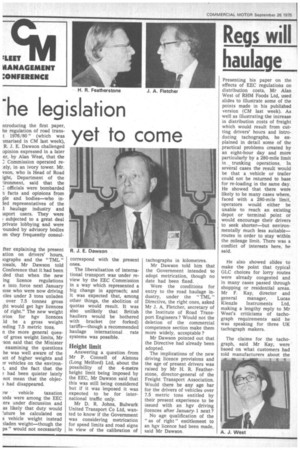he legislation et to come
Page 46

If you've noticed an error in this article please click here to report it so we can fix it.
ntroducing the first paper, he regulation of road trans. t 1976/80" (which was lmarised in CM last week), R. J. E. Dawson challenged opinion expressed in a later er, by Alan West, that the Commission operated re;ely, in an ivory tower. Mr. vson, who is Head of Road ight, Department of the rironment, said that the 2 officials were bombarded a facts and opinions from pie and bodies—who inled representatives of the haulage industry and isport users. They were I subjected to a great deal private lobbying and were -ounded by advisory bodies nin they frequently consul fter explaining the present ation on drivers' hours, tographs and the "TML " )osals, Mr Dawson told Conference that it had been .ded that when the new ing licence regulations e into force next January lose who were now driving cles under 3 tons unladen over 7.5 tonnes gross ;ht would get hgv licences of right." The new weight !rion for hgv licences Id be a gross weight !eding 7.5 metric tons.
n the more general quesof gross weight limits, Mr 'son said that the Minister examining the questions he was well aware of the tct of higher weights and vehicles on the environt, and the fact that the had been quieter lately not mean that the objec; had disappeared.
3W• vehicle taxation iods were among the EEC • ers under discussion and as likely that duty would !uture be calculated on s vehicle weight instead laden weight—though the ps " would not necessarily correspond with the present ones.
The liberalisation of international transport was under review by the EEC Commission in a way which represented a big change in approach; and it was expected that, among other things, the abolition of quotas would result. It was also unlikely that British hauliers would be bothered with bracket (or forked) tariffs—though a recommended haulage international rate systems was possible.
Height limit
Answering a question from • Mr P. Connell of Alstons (Long Melford) Ltd, about the possibility of the 4-metre height limit being imposed by the EEC, Mr Dawson said that this was still being considered but if it was imposed it was expected to be for international traffic only.
Mr D. R. Johns, Bulwark United Transport Co Ltd, wanted to know if the Government was considering metrication for speed limits and road signs in view of the calibration of tachographs in kilometres.
Mr Dawson told him that the Government intended to adopt metrication, though no date had been fixed.
Were the conditions for entry to the road haulage industry, under the " TML " Directive, the right ones, asked Mr J. A. Fletcher, secretary of the Institute of Road Transport Engineers ? Would not the deletion of the commercial competence section make them more widely, acceptable ?
Mr Dawson pointed out that the Directive had already been adopted.
The implications of the new driving licence provisions and the age of present drivers was raised by Mr H. R. Featherstone, director-general of the Freight Transport Association. Would there be any age bar for the drivers of vehicles over 7.6 metric tons entitled by their present experience to be issued with an hgv driving licences after January1 next?
No age qualification of the "as of right" entitlement to an hgv licence had been made, said Mr Dawson.




































































































